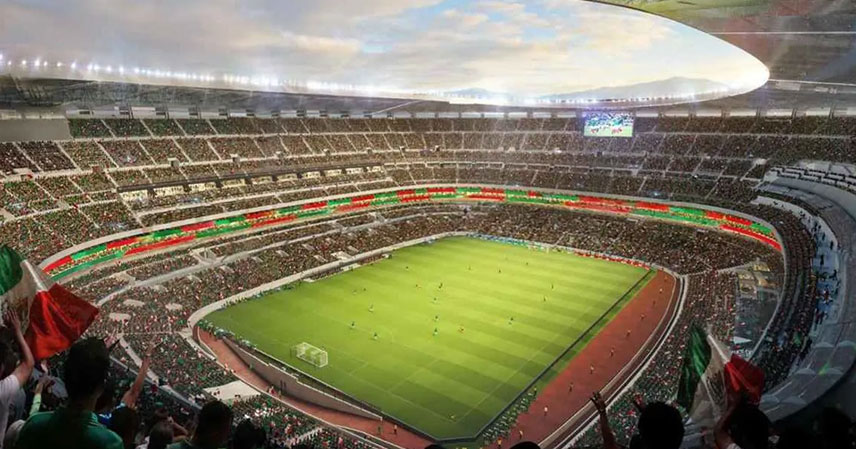Mexico City, a sprawling metropolis of 18 million, is home to a legendary landmark. Azteca Stadium, affectionately known as the Coloso de Santa Úrsula, stands as a testament to football history. It’s a place where legends like Pelé and Maradona graced the pitch. Now, this iconic venue is undergoing a profound transformation. It is preparing to host the 2026 World Cup.
The journey to the stadium can be an adventure in itself. A 15-kilometer drive from the Zócalo, the city’s heart, can take minutes or over an hour. This depends on Mexico City’s notorious traffic. However, the destination promises a glimpse into the future of sports architecture. Azteca Stadium is evolving while preserving its storied past.
The Unprecedented Metamorphosis: A Stadium Reborn 🚧
The first impression of Azteca Stadium today is one of striking contrast. Its familiar, almost ancient exterior belies a hive of activity within. This vast work-in-progress is essential for its role in the upcoming global spectacle. The stadium is set to host five crucial matches in 2026. This includes the inaugural ceremony and the very first World Cup match on June 11.
A friendly match between Mexico and Portugal on March 26, 2026, will serve as a crucial dress rehearsal. The renovations are currently in their most critical phase. The goal is clear: modernize the Colossus to meet stringent international standards. This will significantly enhance the spectator experience. It will also improve the facility’s overall functionality. Crucially, it aims to do so while retaining its historic soul.
The current state reveals a massive construction site. The stands are completely empty. Their signature signs and colors have been removed. Only the gray concrete and scaffolding remain visible. Teams of technicians and engineers work tirelessly, day and night. The field itself, once a pristine green canvas, is now a sea of dirt and mud. Heavy machinery is leveling the ground. It is also reinstalling an advanced drainage system. A state-of-the-art hybrid surface will soon replace the traditional turf. This surface combines natural grass with cutting-edge ventilation and air injection systems.
Architectural Vision and Enhanced Fan Experience 🏟️
The architectural design for Azteca’s revitalization is a careful balance. It aims to modernize without erasing its distinct identity. The main structure of the stadium has been reinforced. However, its iconic shape remains largely intact. This respect for its heritage is a cornerstone of the project. Yet, significant upgrades are being implemented to elevate its appeal and functionality.
The exterior will feature new embellishments. LED banners are being mounted on the characteristic columns and cross beams. These will enhance the stadium’s appearance. They will also allow for colorful, choreographed light shows. From the field level, a major change is immediately apparent. A new metal and glass ring roof is nearing completion. This structure will provide extensive protection for much of the stands. Engineers explain the design philosophy. They did not want to erase the original silhouette. Instead, they sought to update it with lighter, more resilient materials. These materials can better withstand the climate. They also integrate invisible photovoltaic systems for sustainable energy.
The comprehensive project, led by KMD Arquitectos in collaboration with Populous, goes deeper than aesthetics. It completely renovates the electrical, water, and ventilation systems. A smart energy management system is also being installed. Furthermore, it incorporates new FIFA evacuation standards, prioritizing fan safety. While Azteca’s official capacity was around 83,000, renovations could push it closer to 90,000 seats. This would significantly increase its capacity. Individual ergonomic seats are replacing many of the old ones. This ensures increased space and comfort for every spectator. Accessibility and sight lines have also been optimized. This is due to a revised bleacher layout. The fan experience is set for a radical transformation.
Beyond the Pitch: Economic and Cultural Impact 🇲🇽
The modernization of Azteca Stadium extends far beyond the realm of sports. It represents a significant investment in Mexico’s infrastructure. This project carries substantial economic and cultural implications. Hosting the World Cup generates immense tourism revenue. It boosts local businesses and creates numerous jobs. This includes construction, hospitality, and service sectors. The ripple effect across Mexico City’s economy will be considerable. It positions the city as a major global event destination.
Moreover, the revitalized stadium reinforces Mexico’s standing in international football. It showcases the nation’s capacity to host world-class events. The legacy of this transformation will endure for decades. It will attract future sporting and entertainment spectacles. This project is a source of immense national pride. It connects a new generation of fans with the stadium’s legendary past. It ensures that the Coloso de Santa Úrsula remains a symbol of Mexican resilience and passion for football.
Key Insights from Azteca’s Revitalization ✨
- Historic Preservation Meets Modernity: The project skillfully balances maintaining Azteca’s iconic silhouette with integrating cutting-edge technology and infrastructure.
- Enhanced Fan Experience: Significant upgrades, including ergonomic seating, improved accessibility, and a new roof, prioritize spectator comfort and safety.
- Economic and Cultural Catalyst: Beyond football, the renovation and World Cup hosting duties are set to deliver substantial economic benefits and bolster Mexico’s global image.
- Sustainability Integration: The design incorporates smart energy management and photovoltaic systems, reflecting a commitment to environmental responsibility.
As 2026 approaches, the world watches Azteca Stadium’s rebirth. This transformation is more than just a renovation. It is a powerful statement. It speaks to Mexico’s dedication to its football heritage. It also highlights its vision for the future. The Coloso de Santa Úrsula is ready to write its next chapter. It will once again welcome the world to its hallowed grounds.
Source: Here’s What Azteca Stadium Will Look Like for the 2026 World Cup



